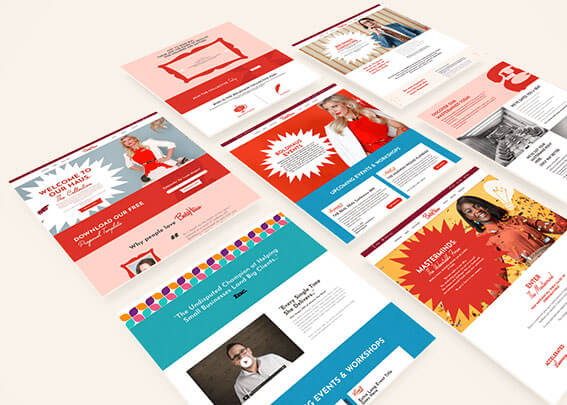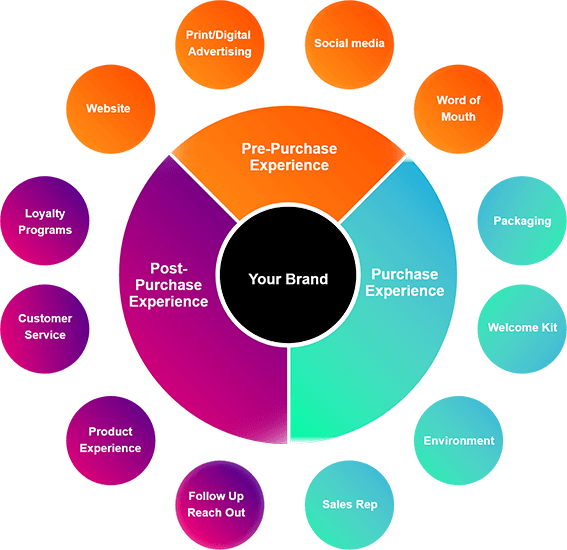Brand Marketing:
Where The Art And Science Of Branding Intersect

The road to creating a world-class brand takes place over three phases.
First comes Brand Strategy, which is what we call “The science of the process.”
Second, comes Brand Identity, “The art.”
That third phase? Brand Marketing.
What is Brand Marketing?
Brand Marketing is where the art and science of the branding process intersect. It is the how you share your brand with the world through intentional outbound marketing endeavors that amplify your presence and impact.
Amplification is what’s key.
Brand Marketing is only valuable if it serves to increase your brand’s visibility. This means engaging in marketing activities that create “touchpoints” with your intended audience that lead to creating a brand experience and, ultimately, your brand’s eventual perception.
Brand touchpoints can be literally anything, including, but not limited to:
- 01. A website
- 02. A retail space
- 03. Direct mail
- 04. Online ads
- 05. E-mail campaigns
- 06. Social media
- 07. Customer Service

01. Website
For most businesses, a website is their most important touchpoint. It is the “home base” for all their business endeavors and the place where a potential customer can learn the most about the type of services or offerings that a company has, who runs the company, what the organization stands for, as well as a storehouse for original content like a blog.
A website is crucial for most businesses; however, just a website alone is not usually enough. After all, how can a customer even know to look at your website if they don’t know you exist.
This is where other touchpoints come in, such as…
Check Out Our Related Blog Posts:
How to make your website stand out.
Rebranding Your Website: 3 Things to Know
02. A retail space
Retail space is another excellent example of a touchpoint where customers get to interact with your brand in a physical location. You can create a curated experience in a retail space that gives visitors a chance to see, touch, taste, and even smell the perception you are looking to develop. So the next time you visit Starbucks, stop and take a deep breath, and recognize that the smell of freshly ground coffee is no accident.


03. Direct mail
Sending communication through the mail isn’t as utilized as it once was, but it is still a powerful touchpoint that you can use to connect with your ideal audience. The days of simply sending a standard letter are over. Instead, brands are getting more and more creative in using direct mail to get your attention and then deliver a powerfully curated message to develop a deeper connection.
04. Online ads
You simply can’t escape online advertising. Whether it’s ads that pop up in your Facebook and Instagram feed while playing your favorite mobile game or even messages that show up on your favorite website, online advertising is everywhere. Unfortunately, many brands’ mistake is not putting careful thought into the kinds of ads they create. A poorly written or designed ad is a touchpoint that can do as much to hurt your brand as it can to elevate it.
Check Out Our Related Blog Post:


05. E-mail campaigns
Whether or not you are a fan of receiving email communication, having an email marketing strategy for your business is essential. Sending weekly newsletters, setting up automations, and implementing strategies to grow your “list” are all necessary tactics in the age of technology. Your customers expect immediate communication and without constant reminders to your customer base, people forget about your services and your brand! Client Relations Management (CRMs) platforms can help you to manage your email campaigns, and monitor and manage your list. There is a wide range of CRM platforms available on the market, it is recommended to map out your requirements and business goals, and then look for a CRM that aligns with your needs and budget.
Check Out Our Related Blog Post:

07. Customer Service
Believe it or not, your customer service department is one of your most essential brand touchpoints. While it’s easy to put on the charm and be helpful to customers before they buy from you, it’s what happens after you make the purchase that really makes a difference. All too often, brands put a ton of forethought into the buying process but neglect what comes next. If you want to see a company that does customer service right, look at Zappos.
Check Out Our Related Blog Post:
What brand marketing is right for you?
Fortunately, businesses have some control over when and where these brand touchpoints occur. Realize that every business has different marketing needs, depending on budget and optimal channels for getting in front of its target audiences. It can be overwhelming and cost-prohibitive to implement every single brand touchpoint through every single channel all at once.
For example, if your customers and prospects interact with your brand in a physical space (e.g., a retail shop or office), creating a branded retail experience will be more important than if your customers and prospects are exclusively online, in which case, you may not need printed business cards or marketing collateral, trade show banners, or building signage.
Thankfully, selecting brand touchpoints and your brand marketing doesn’t have to be a complex calculus problem.
Knowing that every interaction matters, it’s essential to consider the following when determining your brand marketing:
- Precisely which brand touchpoints to focus on
- Which touchpoints will provide the largest impact on your revenue potential or business goals
- That you have a plan in place for implementing those touchpoints to ensure they get completed

Here’s a simple three-step process to prioritize your Brand Marketing activities and brand touchpoints.
Brand Touchpoint
Examples for 3 common touchpoint Categories

Step 1: Make a complete list of the various Brand Marketing actives and Brand Touchpoints for everywhere your target audience could experience them along with the three phases of the customer life cycle.
This includes:
- Pre-Purchase (touchpoints before a sale)
- Purchase (touchpoints at the time of sale)
- Post-Purchase (touchpoints after the sale)
This list is essentially your “customer journey map” you may create when reviewing your customer experience branding. Rather than taking the perspective of your target audience‘s recent experiences, we recommend you start by keeping this broad and considering what other contact points are available (even if you don’t use them)?
By thinking about every phase of the customer life cycle, you can s ensure that you aren’t focusing solely on the front-end of a relationship but considering all points of contact throughout your target audience’s experience.
Below you’ll see a simple map that showcases three common touchpoint categories along the customer cycle.
Step 2: Prioritize your touchpoints based on the potential for impact AND the degree of ease for implementation.
Not every point of contact will be relevant to every business. How many brands need a billboard? How many need to use text messages? How many brands require physical locations for their target audiences? Stationary might be fun to pick out, but will you actually mail anything at all?
We recommend ranking each of your touchpoints on a scale of 1-10 for impact (1 = low impact, 10 = high impact). Then, rank each one on a scale of 1-10 for ease of implementation (1 = difficult, 10 = easy).
When you populate each touchpoint opportunity using these criteria, you can start to determine where to best focus your time, money, and energy. In the chart below, we show you a way to visualize this process.
If creating an email campaign is rated ten (high) for Impact on Business AND ten (easy) for Ease of Implementation, this is considered a “Quick Win” and should be added as a touchpoint. On the other side of the spectrum, suppose you had considered creating a mobile app for your business but rated it as one (low) for impact and one (difficult) for ease of implementation, it should become pretty evident that this is a brand touchpoint to ignore and not prioritize.

Step 3: Add your prioritized Brand Marketing activities and touchpoints and map them along the customer experience journey: Pre-Purchase, Purchase, and Post-Purchase.
With this map in hand, it should now be clear the best use of your time and how to focus on touchpoints that will have the most impact on your business. While you should first focus on the low-hanging fruit that gives you quick wins, it’s also essential to start planning for more long-term touchpoints that take longer but will have a noticeable impact on your brand.
Here’s a simple chart for how to plot this out.
Pre-Purchase
Purchase
Post-Purchase
Quick Wins
(High-Priority Brand Touchpoint to Implement within 30-45 days)
Brand Touchpoint
Brand Touchpoint
Brand Touchpoint
Brand Touchpoint
Brand Touchpoint
Brand Touchpoint
Brand Touchpoint
Brand Touchpoint
Brand Touchpoint
Difficult but noticeable
(High-Priority Brand Touchpoint to Implement within 45-180 days)
Brand Touchpoint
Brand Touchpoint
Brand Touchpoint
Brand Touchpoint
Brand Touchpoint
Brand Touchpoint
Brand Touchpoint
Brand Touchpoint
Brand Touchpoint
Quick Wins
(High-Priority Brand Touchpoint to Implement within 30-45 days)
Pre-Purchase
Brand Touchpoint
Brand Touchpoint
Brand Touchpoint
Purchase
Brand Touchpoint
Brand Touchpoint
Brand Touchpoint
Post-Purchase
Brand Touchpoint
Brand Touchpoint
Brand Touchpoint
Difficult but noticeable
(High-Priority Brand Touchpoint to Implement within 45-180 days)
Pre-Purchase
Brand Touchpoint
Brand Touchpoint
Brand Touchpoint
Purchase
Brand Touchpoint
Brand Touchpoint
Brand Touchpoint
Post-Purchase
Brand Touchpoint
Brand Touchpoint
Brand Touchpoint







06. Social media
Linkedin. Facebook. Twitter. Instagram. Tik Tok. It seems like every day a new social media platform comes onto the scene and smart brands utilize these platforms as a touchpoint. Social media is a great way for you to connect with your audience by sharing ideas, information, and insights about your company and what they care about. It’s even a great way to chide the competition, as Burger King often does to McDonald’s and Wendy’s.
Check Out Our Related Blog Posts:
4 Social Media You Need To Stop Ignoring
Does Your Brand Speak The Language of Social Media?
Why Did Instagram Rebrand?